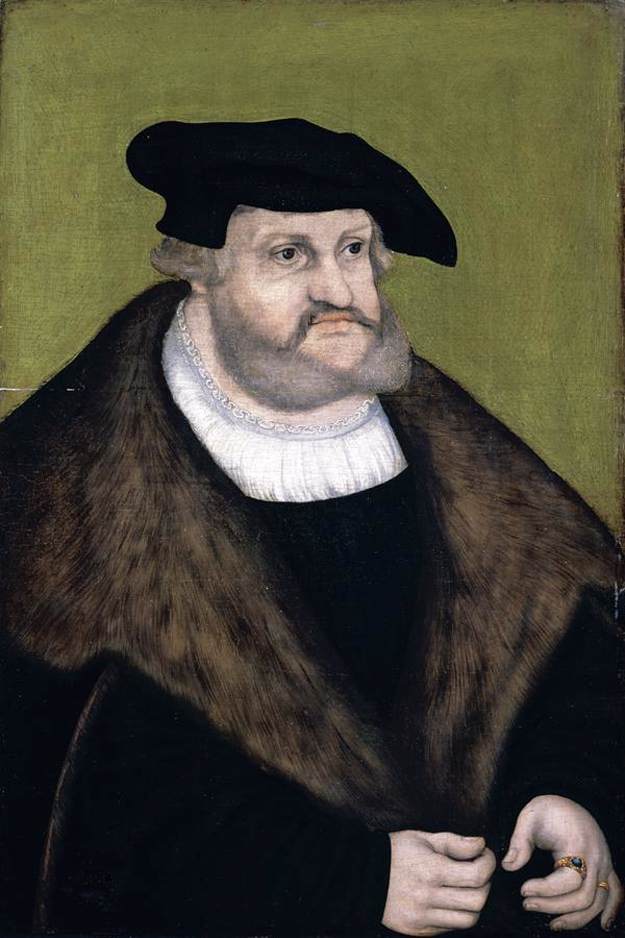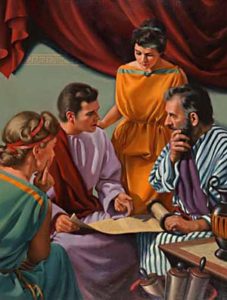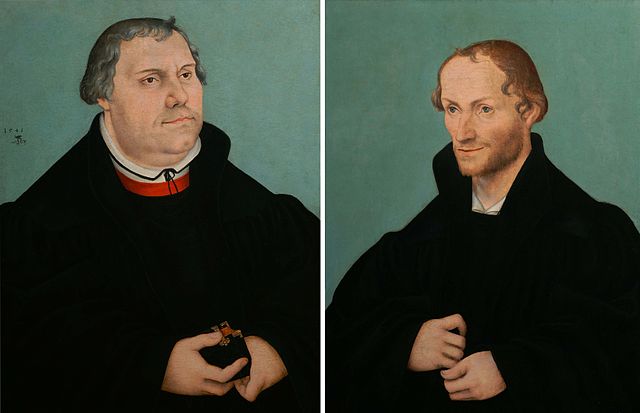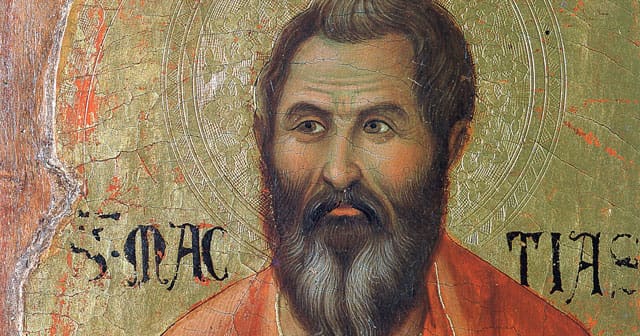In May we remember many people and events at key points in the history of the Church and see how God has always cared for His people and brought about growth to His Church. The saying goes, “April showers bring May flowers,” and this month we remember these men and women of flowers of God which He raised up and used as His instruments to bring about the growth and flourishing of His Church throughout history.
May 1: St. Philip and St. James, Apostles

St. Philip (1st century AD – 80) is one of the Twelve Apostles and is not to be confused with Philip the Deacon who is featured prominently in Acts. St. Philip is listed in the apostolic lists in the Gospels of Matthew, Mark, and Luke, but other than that does not appear. However, in John, Philip is featured prominently in a number of events including the feeding of the five thousand where Jesus tests Philip by asking him where they will buy bread (John 6:1-7); Philip was approached by some Greeks who wished to see Jesus as He neared His passion (John 12:20-23); and he asked Jesus to show them the Father when they were gathered at the Last Supper to which Jesus answers “Whoever has seen me has seen the Father,” (John 14:1-14). Philip is also a great example of the way Christians witness to friends and family, for after being called by Jesus as a disciple Philip finds his friend Nathaniel to tell him about Jesus (John 1:43-45).
St. James (1st century AD) the Less, also known as the son of Alphaeus, is like Philip, one of the Twelve. Like Philip, he is not to be confused with other Jameses in the New Testament including James the Greater (the son of Zebedee) and James the Just (of Jerusalem). Not much is known about James, other than that he was younger or shorter than James the son of Zebedee. Despite both being members of the Twelve we know little of Philip and James, even in extra-biblical tradition. However, in this we see an example for us in the faith today. Not much is recorded because it would seem, not much is extraordinary about them. They were called by the Lord and they continued steadfast in their vocation with no care as to whether they would be remembered, only focusing on sharing the Gospel so that more would know Jesus as the Christ, the Son of God, and be saved.
Philip found Nathanael and told him, “We have found the one Moses wrote about in the Law, and about whom the prophets also wrote—Jesus of Nazareth, the son of Joseph.”
John 1:45
May 2: Athanasius of Alexandria, Pastor and Confessor
Athanasius of Alexandria (c. 296/298 – May 2, 373), was bishop of Alexandria, staunch defender of the deity of Christ, and theologian. Athanasius was born to a Christian family and was given a good secular education. While still a deacon he wrote his famous treatise On the Incarnation of the Word of God which clearly and beautifully teaches on the incarnation of the Word in human flesh. He was close to his bishop Alexander and accompanied him to the Council of Nicea which was convened in 325 in order to deal with the heresy of Arius, a presbyter from Alexandria who argued that Jesus was not fully God. At the death of Alexander Athanasius was elected bishop of Alexandria and continued to steadfastly defend the deity of Christ and His being of “one substance with the Father.” His outspoken defense of Christ’s deity would cause him trouble with Arian (Constantine II), pagan (Julian the Apostate), and Arian friendly (Valens) emperors. Because of this, he would be exiled five times while bishop of Alexandria. While not written by him, the Athanasian Creed is named in his honour because it confesses the same truth which he defended throughout his life.
In the beginning was the Word, and the Word was with God, and the Word was God.
John 1:1
May 4: Friedrich Wyneken, Pastor and Missionary

Friedrich Conrad Dietrich Wyneken (May 13, 1810 – May 4, 1876), was a missionary in the Americas and pastor who helped with the formation of the Lutheran Church – Missouri Synod. Wyneken was born in the Kingdom of Hanover and came to America in order to serve the many Lutherans who at this time had a very difficult time getting pastors. In addition to his time he served as a parish pastor in Friedheim and Fort Wayne, Indiana, he also served as a missionary to the First Nations people in Indiana, Ohio, and Michigan. In response to the difficulties he saw among German Lutherans in getting pastors, he wrote “The Distress of the German Lutherans in North America” calling on Europeans to send pastors to North America. This book is that which inspired Wilhelm Loehe to begin his work of training and sending pastors to North America. He also founded Concordia Theological Seminary in Fort Wayne and was its first president. As the second president of the LCMS he helped to continue to shape its confessional character and helped to organize it, gathering German speaking Lutherans together from Canada to South America.
And how can they preach unless they are sent? Just as it is written, “How beautiful are the feet of those who preach the good news of peace, who preach the gospel of good things!
Romans 10:15
May 5: Frederick the Wise, Christian Ruler

Frederick the Wise (January 17, 1463 – May 5, 1525), was Elector of Saxony and is remembered as a wise and just Christian ruler. Frederick founded the University of Wittenberg, which would become a centre of the Reformation and Reformation teachers. He fought for the cause of justice regarding the various trials of Martin Luther, ensuring that he would not be treated by the Empire like Jan Hus, that is, promised a fair trial and safety but then executed. Because of this, he refused to let Luther go to Rome to face trial. Following the Diet of Worms in 1521 when Luther was formally declared an outlaw in the Empire and thus could be killed by anyone with impunity, Frederick had him kidnapped and hid in Wartburg Castle so that he would be protected from those who sought his life. On his deathbed Frederick received Holy Communion in both kinds, a mark of his confession of the Evangelical faith. He was succeeded by his brother, John the Steadfast, who continued to provide protection for the Reformers in Saxony and advanced the cause of the Reformation among other princes and rulers.
For rulers are not a terror to good conduct, but to evil. Would you like to have no fear of the one in authority? Do what is good, and you will receive praise from him.
Romans 13:3
May 7: C. F. W. Walther, Theologian
Carl Ferdinand Wilhelm Walther (October 25, 1811 – May 7, 1887) was a pastor and important theologian, not just in the founding of the Lutheran Church – Missouri Synod, but for all Lutherans. Walther was one of the pastors who emigrated with the group of pastors and lay people to the United States under Bishop Martin Stephen in order to freely worship after fears of a Union Church (a forced merger of Lutherans and Reformed) began in Saxony. After the sexual misconduct of Martin Stephen resulted in his defrocking and exile, there were serious questions among the immigrants as to whether they were still a church without a bishop. Walther rose to prominence at this time, arguing from the Scriptures and the writings of Luther that a bishop was not of the necessity of the church, but instead it was the pastoral office and laypeople together who made up the church. In the founding of the LCMS, Walther supported a strong confessional position, and encouraged familiarity with the Augsburg Confession among the laity. He founded Der Lutheraner, a magazine which helped to bring many independent German Lutheran congregations into the LCMS. He also founded Concordia Seminary in St. Louis and was its first president. Important works of his include On the Proper Distinction Between Law and Gospel, and Church and Ministry. He also served twice as president of the LCMS.
You see, if I preach the gospel, I have nothing to boast about, because an obligation is laid on me, and woe to me if I do not preach the gospel!
1 Corinthians 9:16
May 9: Job

Job (late 3rd or early 2nd millennium BC) was a blameless and upright man from the land of Uz (Job 1:1) (thought to be connected with Edom, on the west of the Jordan River) and the main person in the book that bears his name. Job was not an Israelite, but predated Jacob, and thus is an example of God’s mercy and love in always ensuring a remnant and that He is remembered. Job, like Melchizedek (another righteous non-Israelite), would have learned of the Lord from the descendants of Noah after the flood who kept the worship of the Lord alive. In the book of Job we see how in the midst of so many trials and temptations that Job remained faithful and steadfast to the Lord God. Because of this, he is cited and alluded to numerous times as an example of steadfastness in the New Testament (Jas. 5:11, 1 Cor. 10:13, 2 Cor. 12:7-10). In the midst of his suffering, Job also confessed the belief in the resurrection of the dead and the life of the world to come, and in doing so, he also prophesied of the coming Messiah who is God and Man in one person (Job 19:23-27). Thus, Job is an example of faithfulness and patience in suffering and holding to the hope of the resurrection and eternal life in the new heavens and new earth.
As for me, I know that my Redeemer lives, and that at the end of time he will stand over the dust. Then, even after my skin has been destroyed, nevertheless, in my own flesh I will see God.
Job 19:25-26
May 11: Cyril and Methodius, Missionaries to the Slavs
Cyril (826 – 869) and Methodius (815 – 885) were two brothers who together through their mission work among the Slavic peoples brought the light of Christ to them. Cyril and Methodius were from Thessolonica and later moved to Constantinople for theological and philosophical study. Around 860, Cyril was first sent as a missionary to the Khazars. By 862, both Cyril and Methodius were sent as missionaries to the Slavic kingdom of Great Moravia. While there, they worked tirelessly to bring the faith to the Slavic peoples. Rather than working in Latin (the language of the West) or Greek (the language of the East and their native language), the two brothers evangelized in the local language. They even invented an alphabet in order to help in the spreading of the faith so that the Scriptures could be translated and passed on in Slavonic. In addition, they used the local language in the liturgy that they developed for the Churches. Combined with the translation of the Scripture this meant that the people would be able to worship and hear the Scripture in their own language. Cyril and Methodius are remembered for their missionary work and are an example for us today in bringing the Gospel to the people in their own language. We give thanks to God for the work among the Slavic peoples that He did through them.
Sing to the Lord a new song. Sing to the Lord, all the earth. Sing to the Lord. Praise his name. Proclaim the good news of his salvation from day to day. Tell about his glory among the nations, about his marvelous deeds among all peoples
Psalm 96:1-3
May 21: Constantine, Christian Ruler and Helena, the Mother of Constantine

Constantine (February 27, 272 – May 22, 337) was the first Christian Roman Emperor, and the one responsible for the legalization of Christianity so that it could no longer be persecuted by the government. While Constantine was raised as a pagan in the Roman imperial religion before the Battle of the Milvian Bridge on October 28, 312 the Lord showed him a vision of a staurogram (⳨) and said, “In this sign, conquer.” Constantine ordered that this be painted on all the army’s shields and when they won the battle, he credited it to the intervention of the God of the Christians. By 313, when the Edict of Milan legalized Christianity, Constantine himself was a Christian. It was under him that the First Council of Nicea was called in order to deal with the Arian heresy.
Helena (c. 246/248 – c. 330) was the mother of Constantine and an important figure for her work in Jerusalem and Palestine. Eusebius of Caesaria, the Christian historian from the time of Constantine, said that Helena converted to the true faith shortly after her son. On a pilgrimage to Jerusalem Helena searched for where the local Christians held that many of the events of Christ’s life took place. At her direction both the Church of the Holy Sepulchre (at the site of Jesus’ death and burial) and the Church of the Nativity (at the place of His birth) were built. According to tradition, she is said to have also discovered the true cross while they were building the Church of the Holy Sepulchre, but this cannot be certain. Together, her and her son are examples of Christian rulers who work to promote peace so that the Gospel of Christ may have free course throughout the realm.
[Wisdom says,] By me kings reign, and rulers administer justice. By me officials govern, as well as nobles and all just judges. I certainly love those who love me, and those who eagerly look for me find me.
Proverbs 8:15-17
May 24: Esther

Esther (500s – mid 400s BC), was a Jewish exile and eventually queen wife of Xerxes I of Persia (Ahasuerus in Hebrew). While in exile, the Lord raised up Esther and used her influence in order to save His people from the plot of Haman after it was discovered by her adoptive father, Mordechai (Esther 2:19-7:10). In order for this to happen, she needed to approach and speak to the king, something which was forbidden and punishable by death if the king did not accept her (Esther 4:11). By God’s grace, Xerxes heard her, and she was able to tell him of the plot of Haman to kill the Jewish people, including her. At this, Xerxes ordered Haman and all the enemies of the Jewish people in Sus, the capital city, to be killed. In great irony Haman was hung on the very gallows he built to hang Mordechai and the other Jews. The Jewish Feast of Purim is held in honour of Esther and God’s deliverance through her. For us Christians she is an example of courage in the face of danger and speaking up for what is right.
If at this time you keep totally silent, relief and deliverance for the Jews will spring up from somewhere, but you and the house of your father will perish. Who knows whether you have become queen for a time like this!
Esther 4:14
May 25: Bede the Venerable, Theologian
Bede (c. 672 – May 26, 735) was an English monk in Northumbria and is known for his historical writings regarding the Church in England as well as his theology. Today Bede is most known for his work, The Ecclesiastical History of the English People, a book that documents the history of the Gospel in England, and a good source of history for the time period. He is also known for helping to popularize the method of dating we use today, Anno Domini, which uses the time of Christ’s birth as the dividing line. However, in his own day and after Bede was known as a theologian. He wrote commentaries on multiple books of the Bible and was also known for his preaching in the monastery where he lived. Today his sermons and commentaries are still valuable resources exegeting the Scriptures and pointing to the centrality of Christ. At the end of his life Bede translated the Gospel of John into Old English demonstrating the importance to him of having the Gospel in the language of the people.
[Jesus] said to them, “Therefore every expert in the law who has been trained as a disciple in the kingdom of heaven is like the owner of a house who brings out of his treasure both new things and old things.”
Matthew 13:52
May 31: The Visitation (Three Year Lectionary)

The Visitation of St. Mary to St. Elizabeth, is a feast which celebrates and commemorates the visit of the Virgin Mary, the Mother of our Lord, to her relative Elizabeth following the annunciation. This event is found in the Scriptures in Luke 1:39-56. In this event in the life of our Saviour we have many memorable scenes which declare what our Lord came to do. It is here where Elizabeth calls Mary, “The mother of my Lord,” confessing the divinity of the Son that Mary carried within her womb. Here too, the Holy Spirit causes St. John the Baptist, still in the womb of his mother Elizabeth, jumped with joy at hearing the sound of Mary’s voice. Thus, even in the womb, John the Baptist pointed to Christ. Finally, it is during the visitation where the Magnificat, the song of Mary, is recorded. The Magnificat is a wonderful hymn of praise which speaks to all that the Lord God will do through Mary’s Son, the Son of God, and as such has been remembered by the Church in having it as the canticle sung at Vespers. If a congregation is following the One Year Lectionary, this feast is celebrated in July.
Just as Elizabeth heard Mary’s greeting, the baby leaped in her womb, and Elizabeth was filled with the Holy Spirit. She called out with a loud voice and said, “Blessed are you among women, and blessed is the fruit of your womb! But why am I so favored that the mother of my Lord should come to me?”
Luke 1:41-43


:max_bytes(150000):strip_icc():format(webp)/Book-of-Philemon-56a148643df78cf7726928a2.jpg)

